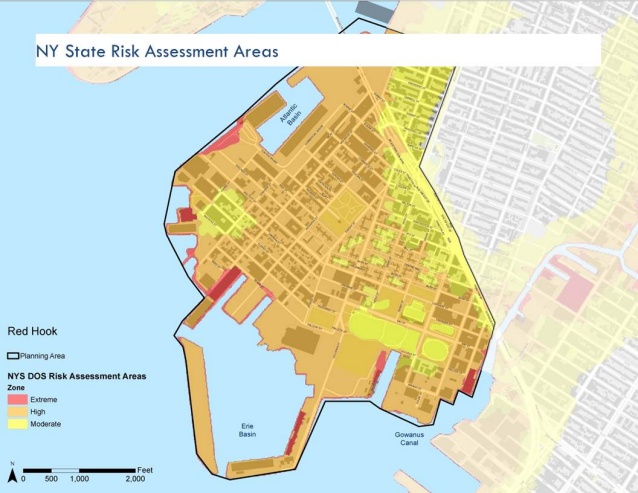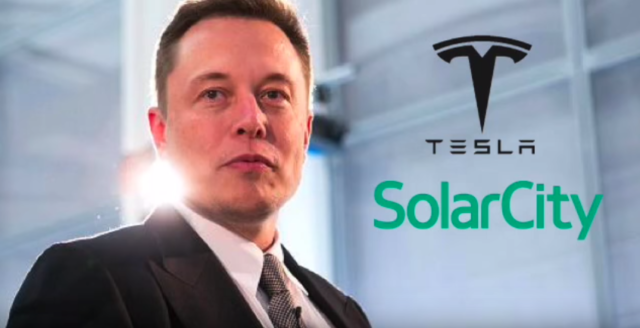>> Microgrids
> U.S.

– NYC Housing Authority Solicits Bids for Brooklyn Community Microgrid
New York State has become a magnet for microgrid project developers thanks to policies, funding, and incentives such as the NY Prize community microgrid challenge. Among the latest developments, the New York City Housing Authority (NYCHA) is soliciting bids to build a district energy microgrid to serve 28 buildings and about 6,300 people on 39 acres in the south Brooklyn neighborhood of Red Hook, a news report highlights.
Located along the historic, long-decaying Brooklyn waterfront, Red Hook was hard hit by Superstorm Sandy in 2011. NYCHA and project partners plan to enhance the provision of energy by building the Red Hook Community microgrid, which should enhance efficiency, reliability, and resiliency while keeping a lid on energy price increases.
NYCHA is looking for a partner that can see to financing, design, construction, installation, and maintenance of the community microgrid, which will include combined heat and power (CHP), otherwise known as co-generation. The system will serve 2,873 apartments as well as commercial buildings, tenants, and a community center.
“Installing a co-generation and district energy system is one of the most efficient ways in NYC to reduce greenhouse gas emissions while ensuring a stable power supply,” said Nilda Mesa, director of the Mayor’s Office of Sustainability. “NYCHA will be harnessing the energy produced in multiple ways, and eliminating individual building systems, which is a smart way to set up a system that will be better to maintain and control.”
– Alaskan Villages Tap Federal Sources for Microgrid Funding
Helping spur sustainable local economic development and job creation are focal points for the U.S. Department of Commerce’s ¨Open for Business¨ agenda and its involvement in stimulating microgrid investment and deployment. The agenda includes Alaska, where Commerce is helping rural communities develop economic development strategies and conserve the environment, says Matt Erskine, deputy assistant secretary for Commerce’s Economic Development Administration (EDA), in a blog post. Erskine recently toured isolated rural Alaskan villages to gain a first-hand understanding of the benefits residents expect from installing self-sufficient microgrids as well as the challenges they face in attempting to do so.
EDA awarded an i6 grant to the Alaska Center for Energy and Power (ACEP), which has gained widespread recognition for its efforts to promote and improve the effectiveness of microgrids in Alaska and beyond. The grant helped ACEP establish the Alaska Center for Microgrid Technologies Commercialization, which provides community members with the technical and business assistance essential to improving microgrid reliability and affordability.
As Erskine explains: ¨Through these initiatives, Alaska is providing the blueprint for the future of new and emerging technologies in rural communities that build on the state’s strengths and natural assets to solve environmental challenges, protect the environment, and simultaneously support businesses and grow the economy.¨
– Tesla-SolarCity Merger May Result in ¨Click and Buy¨ Microgrids

Tesla Motors’ chairman and CEO Elon Musk recently addressed equity analysts’ concerns about its proposed $2.8 billion acquisition of SolarCity. Musk described the prospective value Tesla sees in adding SolarCity’s solar energy finance and installation business lines to Tesla Motors’ rapidly expanding EV and lithium-ion battery-based energy storage product and services lines.
Microgrids’ versatility, providing a range of primary and ancillary energy services from residential to utility scales. On the other hand, these many optionsare sometimes an obstacle hindering faster uptake as policymakers and regulators must keep up with the pace of technological innovation and rising demand.
Complicating matters further are the variety of proprietary technical standards used in microgrid deployments.
“’Paralysis by analysis’ is common, keeping many microgrid projects from escaping the planning stages,” according to a news report. “In the near future, utilities, corporate customers, and communities may design and purchase a microgrid with a few clicks on Tesla’s website.¨ Like individual consumers, utilities and large corporations appreciate purchase options that are fast and simple.
“[Larger customers] don’t have to go through this big laborious process that’s a pain in the butt for them,¨ says Musk. ¨It blows their mind when they can just click a button and then we install their [microgrid] and it works…
“I think it’s always good to productize things — you can click here and buy your microgrid versus having a tailored situation for all over the place. If you can productize it, it can happen so fast. I think that productizing a microgrid — just click here and get a microgrid and it just works — I think that’s a good way to go.”
> Canada
– Back-Up Utility-Scale Microgrid Comes Online in Ontario
Community-owned energy services provider PowerStream and Korea Electric Power (KEPCO) commissioned a utility-scale microgrid in Ontario June 29. Located next to PowerStream’s Robert Street in the town of Penetanguishene, the microgrid will serve as a back-up power generation source meeting the electricity needs of about 400 town residents and businesses for several hours.
Canada’s Parliamentary Assistant to the Minister of Environment and Climate Change MPP Arthur Potts and Markham city Mayor Frank Scarpitti joined PowerStream president and CEO Brian Bentz and KEPCO president and CEO Hwan-Eik Cho at a dedication ceremony held in Penetanguishene.
>> Solar Energy + Storage
> Africa

– Mobisol Tackles Energy Poverty with Off-grid Home Solar-storage Systems
Pioneering young companies are bringing affordable, reliable emissions-free electricity to areas poor in energy resources. Germany’s Mobisol, for instance, has installed 50,000 off-grid home energy systems (a total of around 5 MW) in East Africa including in Rwanda and Tanazania, two of the region’s poorest, most strife-torn nations.
“Mobisol systems are available in four different sizes ranging from 80, 100, 120 to 200 Wp,” the company explains. The smallest unit can illuminate a medium-sized home with seven LED bulbs as well as power a radio, charge various mobile phones, and run a TV for several hours a day.
¨The largest system powers multiple lights, consumer appliances such as a laptop/TV, a DC refrigerator, and up to ten mobile phone chargers simultaneously. There is easily enough electricity created each day to run a small business or for Mobisol customers to simply sell or pass on their excess energy to their community.¨
“When we commercially launched our products three years ago, our main vision was to mitigate climate change,” Mobisol founder and CEO Thomas Gottschalk tells PV Magazine. “Fifty thousand installed solar systems later, I am even more thrilled to see our customers’ happiness when they turn on their lights, TV, and fridge for the first time, or start up a small energy-based business. Access to clean, affordable, and reliable energy literally empowers entire nations to live up to their potential – improving economic well-being and uplifting communities’ quality of life.”
>> Community Solar
> U.S.

– Community Solar Takes Off in Minnesota
Xcel Energy’s Minnesota utility – the largest in the state – has been flooded with applications to build community solar projects, according to a news report. The utility received 430 community solar project applications when it opened its first formal solicitation in December 2014. That number was about 20 times more than management had expected.
Xcel Energy had intended to approve 20 Mws worth of community solar power capacity in Minnesota over the first two years of the program’s life, which began in 2013. Xcel currently has 1,003 more community solar project applications to review.
Speaking at a regional DOE community solar workshop held in Minneapolis this past week, SunShot Initiative acting Director Lidija Sekaric deemed community solar “the second wave in deployment in the solar space,” following utility-scale and privately owned or leased rooftop systems, according to an E&E Publishing news report written by Daniel Cusick.
Sekaric point out that community solar ¨differs from these more mature markets in key ways, most notably by spreading the costs and benefits of solar across a much broader spectrum of society.
“It is solar for all, and it can be had in any quantity that you can afford. It’s a matter of markets, it’s a matter of opportunity, and it’s a matter of fairness and access” to clean power.
– Vermont Raises Green Mountain Power’s Net Metering Capacity
Vermont’s Public Service Board approved Green Power Mountain’s request to connect an additional 7.5 MWs of new solar power capacity to its grid, the largest in the state.
As per the ruling, projects will be limited to 150 kW power capacity, which means Green Mountain Power can connect at least 50 new solar power projects to its grid this year. The deadline for applications is July 11.
PSB’s approval also requires new projects be installed in locations where the utility grid has the capacity to take on new renewable energy. Furthermore, solar panels must be installed on customers’ or neighboring properties, and a minimum of 50 percent of the energy produced must be used by the customer.
“There is a lot of interest in these solar projects, and that’s why we wanted to continue with unlimited rooftop projects for customers,” Green Mountain Power’s Kristin Carlson says. “And it also includes a portion of community solar projects for people who can’t go solar on their own rooftops.”
